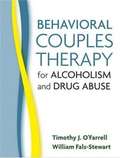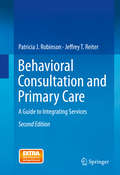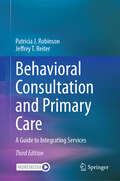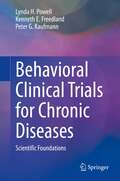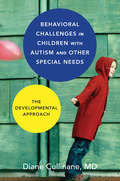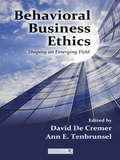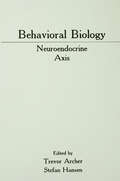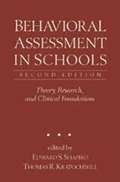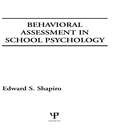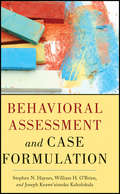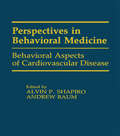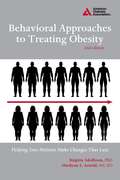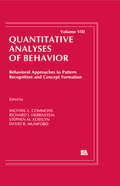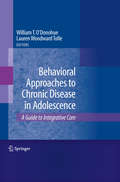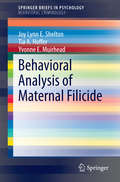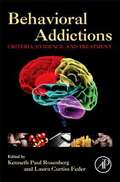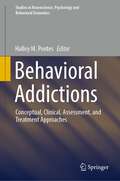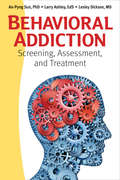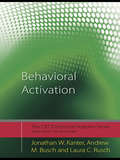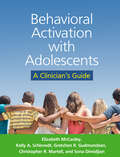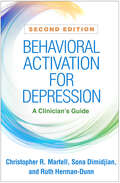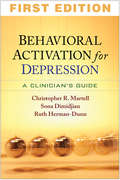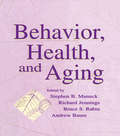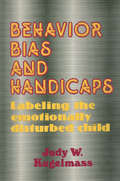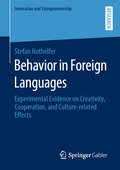- Table View
- List View
Behavioral Couples Therapy for Alcoholism and Drug Abuse
by William Fals-Stewart Timothy J. O'FarrellThis eminently practical guide presents an empirically supported approach for treating people with substance abuse problems and their spouses or domestic partners. Behavioral couples therapy (BCT) explicitly focuses on both substance use and relationship issues, and is readily compatible with 12-step approaches. Provided are all the materials needed to introduce BCT; implement a recovery contract to support abstinence; work with clients to increase positive activities, improve communication, and reduce relapse risks; and deal with special treatment challenges. Appendices include a condensed session-by-session treatment manual and 70 reproducible checklists, forms, and client education posters. The large-size format and lay-flat binding facilitate photocopying and enhance the book's clinical utility. Recommended by the National Institute for Clinical Excellence (NICE) for use in National Health Service treatment units
Behavioral Consultation and Primary Care: A Guide to Integrating Services
by Patricia J. Robinson Jeffrey T. Reiter"In this 2nd edition, Robinson and Reiter give us an updated blueprint for full integration of behavioral health and primary care in practice. They review the compelling rationale, but their real contribution is telling us exactly HOW to think about it and how to do it. This latest book is a must for anyone interested in population health and the nuts and bolts of full integration through using the Primary Care Behavioral Health Consultation model. " Susan H McDaniel Ph. D. , 2016 President, American Psychological Association Professor, University of Rochester Medical Center The best-selling guide to integrating behavioral health services into primary care is now updated, expanded and better than ever! Integration is exploding in growth, and it is moving inexorably toward the model outlined here. To keep pace, this revised text is a must for primary care clinicians and administrators. It is also essential reading for graduate classes in a variety of disciplines, including social work, psychology, and medicine. This updated edition includes: · A refined presentation of the Primary Care Behavioral Health (PCBH) model · The latest terms, trends and innovations in primary care · Comprehensive strategies and resource lists for hiring and training new Behavioral Health Consultants (BHC) · Step-by-step guidance for implementing the PCBH model · A plethora of evolved practice tools, including new Core Competency Tools for BHCs and primary care providers · Sample interventions for behaviorally influenced problems · The use of "Third Wave" behavior therapies in primary care · Detailed program evaluation instructions and tools · The latest on financing integrated care · An entire chapter on understanding and addressing the prescription drug abuse epidemic · Experienced guidance on ethical issues in the PCBH model · Improved patient education handouts With all of the changes in health care, the potential for the Primary Care Behavioral Health (PCBH) model to improve primary care--and the health of the population--is greater than ever. This book should be the first read for anyone interested in realizing the potential of integration.
Behavioral Consultation and Primary Care: A Guide to Integrating Services
by Patricia J. Robinson Jeffrey T. ReiterThis third edition of Behavioral Consultation and Primary Care builds on the success of the previous editions, with updates and expansions of material. This volume will address many timely developments and will be useful to those professionals new to integrated care, and will serve as a text for the growing number of graduate courses on primary care consultation. Topics of interest include workforce shortage issues, guidance on growing strong and resilient teams, and an exploration of the spread of this model to a wide variety of settings such as family practice, women's clinics, and pediatric facilities. In all, the goal of this book is to provide better health care for everyone, and provide the steps necessary to achieve this goal. Robinson and Reiter have crafted a masterpiece with this third edition of Behavioral Consultation and Primary Care. Their great care in building the PCBH model explains its positive impact on patients and healthcare systems around the world and its remarkable growth over the past 17 years. This edition, enriched with new research, practical tools, evolved thinking, and the authors' stunning ability to keep things simple, is a tour de force of how to make evidence-based work clinically relevant. I am thrilled to see this comprehensive guide continue to advance the field. It’s THE essential resource for clinicians, leaders, and anyone who is passionate about transforming primary care through behavioral health integration. Steven C. Hayes, PhD, Foundation Professor of Psychology Emeritus, University of Nevada, Reno Expect this book to be dog-eared and covered with notes. This is not a pristine book to sit on your shelf. This is your go-to guide for integrating behavioral health services into primary care. From the basics to the complex nuances of implementation and scaling integration — this is your resource. Whether you are just starting to integrate behavioral health into your practice, or have a seasoned integrated system, this book is for you. Parinda Khatri, PhD, Chief Health Officer, Cherokee Health Systems
Behavioral Clinical Trials for Chronic Diseases: Scientific Foundations
by Lynda H. Powell Peter G. Kaufmann Kenneth E. FreedlandThis is the first comprehensive guide to the design of behavioral randomized clinical trials (RCT) for chronic diseases. It includes the scientific foundations for behavioral trial methods, problems that have been encountered in past behavioral trials, advances in design that have evolved, and promising trends and opportunities for the future. The value of this book lies in its potential to foster an ability to “speak the language of medicine” through the conduct of high-quality behavioral clinical trials that match the rigor commonly seen in double-blind drug trials. It is relevant for testing any treatment aimed at improving a behavioral, social, psychosocial, environmental, or policy-level risk factor for a chronic disease including, for example, obesity, sedentary behavior, adherence to treatment, psychosocial stress, food deserts, and fragmented care. Outcomes of interest are those that are of clinical significance in the treatment of chronic diseases, including standard risk factors such as cholesterol, blood pressure, and glucose, and clinical outcomes such as hospitalizations, functional limitations, excess morbidity, quality of life, and mortality. This link between behavior and chronic disease requires innovative clinical trial methods not only from the behavioral sciences but also from medicine, epidemiology, and biostatistics. This integration does not exist in any current book, or in any training program, in either the behavioral sciences or medicine.
Behavioral Challenges in Children with Autism and Other Special Needs
by Diane CullinaneThis book offers a comprehensive view of behavioral challenges for a child with autism or other special needs from a developmental perspective based on the DIRFloortime® framework. Parents and professionals are guided to understand and improve a child's behavior while also supporting underlying developmental capacities for shared attention, warm engagement, trust, initiative, creative shared problem solving, symbolic and logical thinking, and the development of personal values. The approach is presented in three parts. Step-by-step, clinicians, caretakers, and educators will learn how to use the developmental approach to:1. Understand the many variables involved in the behavior of a child with special needs,2. Effectively respond to a challenging behavior in the moment with three key steps: attune, help, and recover3. Create a long-term plan to support developmental and behavioral progress. When a child with a disability has a behavioral challenge, a clinician is confronted with the complexities of the child's developmental strengths and vulnerabilities, individual differences, and his or her unique pattern of interactions in personal relationships. Keeping all the variables in mind, the developmental approach provides a plan that supports a child's growth and deepens his or her capacity for perspective and care for others. The framework is based on universal developmental principles, which are effective regardless of the child's particular age or disability. By recognizing a child's developmental level of functioning, an adult can select strategies to effectively guide the child toward higher levels of relating, thinking and communicating. Through the process of compassionate attunement, and building on a child's strengths, adults can optimistically chart a clear path to long-term success. A refreshing alternative to rewards-and consequences-based models of behavior management, the methods and practices in this book will empower any adult who interacts with a child with special needs, whether their work is directly focused on improving behavior, or because they must provide support so that the child can participate in other endeavors.
Behavioral Business Ethics: Shaping an Emerging Field (Organization and Management Series)
by Ann E. Tenbrunsel David De CremerThis book takes a look at how and why individuals display unethical behavior. It emphasizes the actual behavior of individuals rather than the specific business practices. It draws from work on psychology which is the scientific study of human behavior and thought processes. As Max Bazerman said, "efforts to improve ethical decision making are better aimed at understanding our psychological tendencies."
Behavioral Biology: Neuroendocrine Axis
by Trevor Archer Stefan HansenThis book is the result of an international symposium in biological psychology, held in honor of Knut Larsson. This renowned researcher -- in his search for the true meaning of "mind vs. matter" -- became involved in many divergent areas of the field, such as the neurobiology of sexual behavior and sexual differentiation, aspects of functional neuroanatomy, behavioral endocrinology, and psychopharmacology. Through experimentation and much consultation with other area specialists, Larsson observed such phenomena as the adaptation of behavior-determining neuroendocrine events to the physical environment and the hormonal regulation of sexual behavior and differentiation. This tribute to his research presents important features of necessary paradigms for the analysis and study of experimental psychology within the biological perspective.
Behavioral Assessment in Schools: Theory, Research, and Clinical Foundations (2nd edition)
by Edward S. Shapiro Thomas R. KratochwillA landmark text, this volume systematically addresses the issues involved in developing behavioral assessment strategies for educational--rather than clinical--settings. The theoretical and conceptual underpinnings of widely used assessment methods are discussed, and their strengths and limitations evaluated.
Behavioral Assessment in School Psychology (School Psychology Series)
by Edward S. ShapiroThis important volume presents strategies and procedures for assessing both emotional/behavioral problems and academic difficulties. Arranged by assessment content areas, the volume discusses such methodologies as behavioral interviewing, observation, self-monitoring, use of self- and informant-report, and both analogue and curriculum-based assessment. All chapters are supported by numerous examples and illustrations.
Behavioral Assessment and Case Formulation
by William O'Brien Joseph Kaholokula Stephen N. HaynesComprehensive, scientifically based coverage on conducting behavioral assessments, analyzing results, and forming clinical recommendationsBehavioral Assessment and Case Formulation thoroughly outlines the underlying principles of the behavioral assessment process. This book clearly explains how the principles and methods of behavioral assessment central to the formulation of functional analysis are also helpful in guiding strategies for determining interventions and measuring the processes and outcomes.This comprehensive resource offers up-to-date answers to relevant questions of the clinical assessment process, including:What is the best assessment strategy to use with a particular client?Which assessment methods will best capture a client's unique strengths,limitations, behavior problems, and intervention goals?How can data from multiple sources be integrated in order to yield a valid and clinically useful case formulation?Which procedures should be enacted in order to insure a positive clinician-client relationship?How should intervention processes and outcomes be measured and monitored?Filled with case studies, Behavioral Assessment and Case Formulation provides guidelines for the application of behavioral assessment strategies and methods that can strengthen the validity and utility of clinical judgments, as well as improve the delivery of care.
Behavioral Aspects of Cardiovascular Disease (Perspectives on Behavioral Medicine Series)
by Andrew Baum Alvin P. ShapiroSmoking, diet, stress, coping, and exercise, among other behaviors and psychological states, are now clearly implicated in the development of cardiovascular diseases. Prevention, based largely on altering behaviors that contribute to this chronic disease, is now as important a goal as is treatment of those already afflicted. This volume, based on a recent meeting of the Academy of Behavioral Medicine Research, addresses several important areas of research in the general area of cardiovascular disease. The topics covered reflect on important aspects of this phenomenon, such as the long-term development of coronary artery disease; central nervous system (CNS) regulation of blood pressure, heart rate, and sympathetic tone playing a pivotal role in sympathetic activity and hypertension; learned blood pressure modulation and baroreceptor activation as a means of reducing the aversiveness of stress or noxious stimulation; and the notion that symptoms of heart disease or infarction may occur in the absence of organic heart disease. Having been impressed by the recent advances in the field, the editors of this book capture the wealth of newly acquired knowledge about behavioral factors in cardiovascular disease and how the body's nervous, endocrine, and cardiovascular systems work together.
Behavioral Approaches to Treating Obesity
by Marilynn S. Arnold Birgitta AdolfssonAs governments and health care systems direct more attention and resources to treating the rising rates of obesity worldwide, one thing has become very clear: obesity is best treated as a chronic condition. The most effective approach to care is often a behavioral one, in which health care providers and patients rely on teamwork, respect, and conversation to motivate lifestyle change. This collaborative model is essential because decisions about care ultimately rest with the patient. Working together, care providers and patients can help patients learn to make healthy choices throughout their lives.An effective and detailed guide for health care providers, Behavioral Approaches to Treating Obesity embraces this understanding about treating obesity and explains how to help patients direct their own lifestyle change. With this self-directed approach to clinical care, patients assume more responsibility for their treatment plans, whereas care providers learn to take on the role of guide or counselor.In this book, readers will find strategies for encouraging patients and equipping them for lifestyle change. There is practical advice on many issues and helpful guides for any of a number of difficult scenarios. Some of the features of this guide include:arranging the physical environment of a clinic to accommodate obese patientsbuilding a program to meet the needs of patients in a chronic-care treatment plancase studies to illuminate key issues in behavior changecharts and tables to help implement behavioral approaches in treatmentstep-by-step instructions on helping patients begin lifestyle changedescriptions of how to design and organize an obesity treatment programuseful methods of building a collaborative health care teamReaders will start at the beginning, learning to understand the problems of obesity and risks it poses to the people who suffer from the condition. Then the methods of treatment for obesity are presented, along with analysis of these methods and their effectiveness. In the end, the authors conclude that a new paradigm of care is needed to successfully treat obesity.The next section spends some time redefining the roles of health care providers in providing a collaborative care model of behavioral change therapy. The authors describe the new roles for health care providers and how to cope with those changes, how to build their team, how to create a supportive environment, and then how to structure the care process.The third and final section provides health care providers with the tools they need to introduce behavioral self-care in the clinical environment. This is a step-by-step process, and each step is further explained using case studies from the authors' experiences.The book is completed with an extensive resources section and an updated reference list to promote further research.
Behavioral Approaches to Pattern Recognition and Concept Formation: Quantitative Analyses of Behavior, Volume VIII (Quantitative Analyses of Behavior Series)
by Stephen M. Kosslyn Richard J. Herrnstein Michael L. Commons David B. MumfordVolume eight in this highly acclaimed series discusses the behavioral approaches to pattern recognition and concept formation in two sections: categories and concepts in birds, and shape and form. An ideal reference for students and professionals in experimental psychology and behavioral analysis.
Behavioral Approaches to Chronic Disease in Adolescence: A Guide to Integrative Care
by William O'Donohue Lauren TolleAdolescence is typically fraught with problems, even under optimal conditions. And when chronic illness is added to the picture, medical and related social issues can complicate, and even disrupt, the course of development. The first text geared toward the integrated care setting, Behavioral Approaches to Chronic Disease in Adolescence offers clinicians an evidence-based guide to helping their young clients manage their chronic conditions and treating the psychosocial effects--from school problems and stigma to noncompliance and depression--that frequently follow diagnosis. Expert contributors present up-to-date information on epidemiology, symptoms, comorbid psychosocial problems, and treatment options for a variety of common illnesses, arranged to foster effective interventions for adolescents and efficient collaboration with other care providers in the team. Coverage is comprehensive, authoritative, and accessible, ensuring best practice while respecting each client's individuality: Empirically-based treatment guidelines for illnesses commonly found in youth, including Type 1 and 2 diabetes, asthma, cancer, obesity, and chronic pain. Overview of the physiology of adolescence, particularly as it may be affected by medical conditions, and of adolescent brain development. Latest findings on the role of families in teens' adjustment to illness and treatment. Cultural considerations affecting ethnically diverse clients and their families. Detailed discussions of ethical issues relevant to treating chronically ill young people, and of controversies involving pharmacotherapy with this population. Chapters contain useful handouts for clinicians and clients. Taking Care of the Practitioner" chapter with helpful strategies for avoiding burnout. Its emphasis on specific practical information makes Behavioral Approaches to Chronic Disease in Adolescence a "go-to" reference for health psychologists, child and adolescent mental health practitioners, pediatricians and family practitioners, and clinical social workers.
Behavioral Analysis of Maternal Filicide (SpringerBriefs in Psychology)
by Tia A. Hoffer Joy Lynn E. Shelton Yvonne E. MuirheadMaternal filicide has been discussed in the medical, mental health, and child abuse fields, yet little research exists with a criminal justice/law enforcement perspective. Nevertheless, criminal justice professionals responsible for investigation and prosecution of these offenders often must give attention to unique behavioral, social, and psychological dynamics not considered in many other types of cases. The Federal Bureau of Investigation's (FBI) Behavioral Analysis Unit (BAU) III - Crimes Against Children identified, collected, and reviewed law enforcement case files in which a biological mother killed her child(ren). Collectively, the cases involve 213 biological mothers who killed 265 children, and are comprised of neonaticide, infanticide, and filicide cases. Data analysis revealed that the offenders ranged in age from 12-46 years, and many were unmarried, unemployed, and had a history of violence. Many of the victims were three years of age or younger, did not live with their biological fathers at the time of their deaths, and had a history of maltreatment most often perpetrated by their mothers. In addition, traditional weapons such as a firearm or knife were used less often compared to asphyxiants and blunt force instruments. The authors explore the tenets of female violence, the mother-child dynamic and mental disorders, and address the complexities associated with investigating and prosecuting maternal filicide offenders.
Behavioral Addictions: Criteria, Evidence, and Treatment
by Kenneth Paul Rosenberg Laura Curtiss Feder<p>DSM-V broke new ground in May of 2013, designating a new disorder called "behavioral addiction." Clinicians immediately wanted to know: how is a behavioral addiction different from an impulse control disorder? What are the criteria for determining that some behaviors are addictions rather than impulses? What, if anything, does this mean in terms of effective treatment? <p>Behavioral Addictions is the first and most authoritative text ever written on the subject of behavioral addictions. This comprehensive work explains the criteria used to determine addiction, the evidence for identifying assorted behaviors as addictions, and the evidence-based treatment for each. <p>With contributions from preeminent experts covering an exhaustive list of behavioral addictions, this book is unique in its coverage of behavioral addictions, their criteria, and treatment. It is a valuable and timely resource for any clinician treating addictions.</p>
Behavioral Addictions: Conceptual, Clinical, Assessment, and Treatment Approaches (Studies in Neuroscience, Psychology and Behavioral Economics)
by Halley M. PontesThis book provides a holistic evidence-based perspective on conceptual, clinical, assessment, and treatment aspects of key non-substance-based addictive disorders related to: gambling, gaming, social media, smartphone, internet, love, sex, exercise, work, and shopping. Each chapter focuses on a different addictive disorder and is structured in a user-friendly way to enable the reader fast navigation, yet the main aspects of the respective disorders are covered in the necessary depth. All in all, this book offers a timely, self-contained introduction to both key concepts and the latest scientific developments in behavioral addictions. It addresses mental health practitioners, researchers in psychology, neuroscience and communication, and undergraduate and postgraduate students alike.
Behavioral Addiction
by Larry Ashley Lesley Dickson An-Pyng SunWritten in scientific prose that can also be understood by the layperson, this comprehensive volume is a must-read for those working in the addiction field and anyone interested in learning more about this devastating disease.An-Pyng Sun, PhD, is a professor at the University of Nevada, Las Vegas School of Social Work.Larry Ashley, EdS, LCADC, is the addictions specialist and undergraduate coordinator at the University of Nevada, Las Vegas.Lesley Dickson, MD, is ABPN board-certified in general psychiatry, addiction psychiatry, and psychosomatic illness.
Behavioral Activation: Distinctive Features (CBT Distinctive Features)
by Jonathan W. Kanter Laura C. Rusch Andrew M. BuschBehavioral activation theory indicates that much clinically relevant human behavior is a function of positive reinforcement, and that when positive reinforcement is reduced, lost, or chronically low depression results. Behavioral activation encourages clients to obtain and nurture the skills that allow them to establish and maintain contact with diverse, stable sources of positive reinforcement. This creates a life of meaning, value and purpose. Behavioral Activation: Distinctive Features clarifies the fundamental theoretical and practical features of behavioral activation, integrating various techniques into a unified whole that is efficient and effective. The book includes numerous case examples and transcribed segments from therapy sessions and outlines behavioral concepts using straightforward terms and examples so that all therapists can see the utility and practical value of this approach. This book will provide essential guidance for students and new therapists, as well as more experienced clinicians wanting to know more about what makes behavioral activation a distinct form of cognitive behavior therapy.
Behavioral Activation with Adolescents: A Clinician's Guide
by Sona Dimidjian Kelly A. Schloredt Gretchen R. Gudmundsen Christopher R. Martell Elizabeth McCauleyThis book presents the first behavioral activation (BA) program to help 12- to 18-year-olds overcome depression. The authors provide a systematic framework for increasing adolescents' engagement in rewarding activities and decreasing avoidant behavior. User-friendly features include session-by-session guidelines and agendas, sample scripts, and instructional materials. Strategies are described for actively involving parents and tailoring BA to each teen's needs and developmental level. In a large-size format for easy photocopying, the book contains 35 reproducible handouts. Purchasers get access to a Web page where they can download and print the reproducible materials.
Behavioral Activation for Depression, Second Edition: A Clinician's Guide
by Sona Dimidjian Christopher R. Martell Ruth Herman-DunnNoted for its clarity and practical utility, the definitive guide to behavioral activation (BA) is now in a revised and expanded second edition. The authors are leading experts who enumerate BA principles and provide guidelines for assessment and intervention. Clinicians learn effective procedures for structuring each session, identifying and scheduling antidepressant activities, targeting avoidance and rumination, and monitoring progress. Illustrated with an extended case example, sample dialogues, and quick-reference tables, the book features 16 reproducible worksheets and forms. Purchasers get access to a Web page where they can download and print the reproducible materials--plus a supplemental client booklet--in a convenient 8 1/2" x 11" size. New to This Edition *Reflects a decade of advances in research, clinical practice, and training. *Chapter on transdiagnostic applications and new treatment settings. *Four additional reproducible appendices: measures of BA client progress and therapist treatment fidelity. *Supplemental downloadable booklet: A Client's Guide to Behavioral Activation.
Behavioral Activation for Depression
by Sona Dimidjian Christopher MartellFrom leading experts in behavioral activation research and clinical practice, this volume presents an empirically tested approach for helping clients overcome depression by becoming active and engaged in their own lives. Behavioral activation is a stand-alone treatment whose principles can be integrated easily with other approaches that therapists already use. Guidelines are presented for identifying individualized treatment targets, monitoring and scheduling \u201cantidepressant\u201d activities--experiences that are likely to be rewarding and pleasurable--and decreasing avoidance and ruminative thinking. Rich clinical illustrations include an extended case example that runs throughout the book. More than 20 activity planning forms, worksheets, and other reproducible materials are featured, which book purchasers can also download and print.
Behavior, Health, and Aging (Perspectives on Behavioral Medicine Series)
by Andrew Baum Stephen B. Manuck Richard Jennings Bruce S. RabinA dramatic shift in the average age of the U.S. population and the increasing number of elderly Americans has introduced new and challenging healthcare dilemmas. This book addresses these issues with contributed chapters by the leading authorities in the field of behavioral medicine. It deals with health and healthcare needs of the elderly by considering basic changes that result from aging and some of the more specific problems that accompany it. Content highlights include a review of the basic tenets of genetics and molecular biology including some of the methods of looking at heritable differences in health and well-being. Quality of life concerns are addressed, including the differences between men and women, as well as other gender issues. Several chapters deal with the effects of aging on immunity. The latter part of the book emphasizes the psychosocial implications of aging on cardiovascular disease. Chronic illness among the elderly is also addressed.
Behavior, Bias and Handicaps: Labelling the Emotionally Disturbed Child
by Judith W. KugelmassFirst Published in 2017. Routledge is an imprint of Taylor & Francis, an Informa company.
Behavior in Foreign Languages: Experimental Evidence on Creativity, Cooperation, and Culture-Related Effects (Innovation und Entrepreneurship)
by Stefan NothelferWorking and interacting in foreign languages is widespread. While the relationship between language and behavior has been discussed for many years, empirical evidence for behavioral effects of foreign language use is surprisingly scarce. Stefan Nothelfer has conducted a series of laboratory studies to investigate and disentangle effects of language and culture on creativity and cooperation, important behavioral foundations of innovation. He draws insights from a large cross-country dataset with pairings between three languages, using a custom-built mobile laboratory. The author’s findings challenge theories of linguistic relativity, foreign language effects, and cultural accommodation, and enrich the empirical basis for fundamental research on language and behavior.
